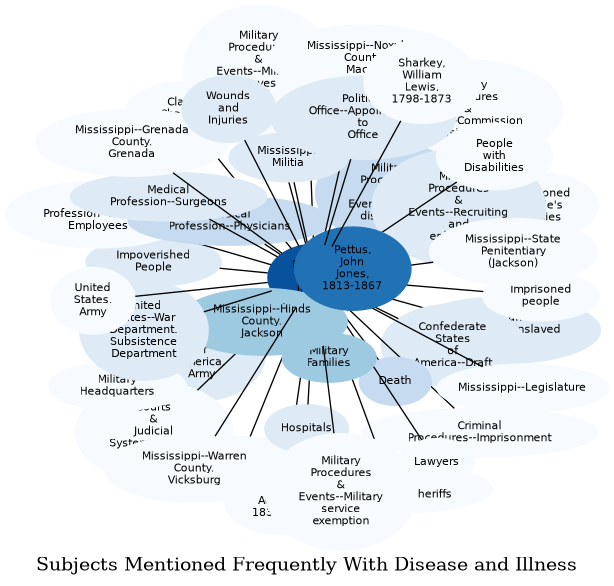Description
Approximately 620,000 Americans died during the Civil War. For this reason, the war is often called America’s bloodiest conflict. However, two-thirds of Civil War deaths were caused by disease, not combat. The disparity is greater for non-fatal victims: 400,000 soldiers suffered wounds or injuries compared to 6,000,000 cases of illness. Since a combined 3,000,000 men fought in Union and Confederate armies, this means the average soldier fell ill to disease twice during his military service.
Numerous types of diseases afflicted soldiers and civilians during the Civil War and Reconstruction era. Some were ubiquitous, like the common cold and diarrhea, which rarely garnered much attention unless the symptoms worsened into a more severe condition. Pneumonia, typhoid, and malaria were among the most serious diseases in the mid-nineteenth century. Epidemics of yellow fever and small pox also ravaged some civilian communities and military units. Perhaps the most deadly to Civil War soldiers, though, was dysentery, which was diarrhea with blood in the stool. Nearly 60,000 people died from dysentery during the war, and Union officials recorded 1.5 million cases of diarrhea or dysentery between 1861 and 1865.
All Americans, regardless of economic status or race, suffered pain and loss due to illness during the era. The President of the United States Abraham Lincoln and President of the Confederate States Jefferson Davis—the two most powerful individuals in North America, with access to the best resources—each lost a child to disease during the Civil War. The problem worsened with the sudden shifting of human populations during and after the war, as outbreaks of diseases spread rapidly. While many soldiers from highly populated areas had developed immunity to childhood diseases such as chicken pox, diphtheria, mumps, measles citizen soldiers from rural areas proved more susceptible to severe reactions when exposed to those diseases. Physicians improved medical care during the Civil War, as many recognized the value of sunlight and fresh airflow. However, they could only provide soldiers such healthy conditions behind the lines, at hospitals or rest areas. In many camps, or in the field during campaigns, soldiers were exposed to poor weather, extreme temperatures, and unsanitary conditions. Those who suffered the worse were in prisoner of war camps, in both north and south, where thousands of soldiers died from dysentery or other diseases. Civil War doctors did not fully understand the spread of diseases, including contaminated water (in the case of typhoid and dysentery) or mosquitos (for malaria and yellow fever). As such, camps, forts, and prisons rarely were constructed with the soldiers’ health in mind, and Civil War medicine most often involved responding to disease rather than preventing it.
Another source of illness among soldiers, and civilians in war-torn areas, was dietary deficiencies. Despite efforts by subsistence and commissary personnel in Union and Confederate armies, feeding thousands of troops daily proved a monumental task. Food preservation techniques still relied heavily upon drying and salting, and fresh vegetables and fruits were limited and dependent upon seasons. As a result, most Civil War soldiers likely suffered from a Vitamin C deficiency, the most severe cases resulting in scurvy which caused the loss of teeth and bleeding. Heavy reliance upon corn-based foods, especially within southern military units or Union prisoners held in southern prisoner of war camps, led to high instances of pellagra, a condition caused by the lack of niacin (or vitamin B3). Present in most foods, but not corn, victims suffered from diarrhea, skin sores, and dementia.
Often ignored, Americans also suffered from sexually transmitted diseases during the Civil War and afterwards. Although rarely fatal, more than 100,000 soldiers were diagnosed with gonorrhea and nearly 80,000 became infected with syphilis. Unsurprisingly, most of these cases occurred when soldiers were near populated areas, especially during training or time in camp, where they had more opportunities to interact with women. Venereal disease rates were higher at the start and at the end of the Civil War. That trend may reflect the fact that rates went down for armies on campaign in the field. The overall rate of venereal disease in the Union Army fluctuated from about 82 to 87 cases for every 1,000 soldiers, Some Union military units reported extremely high rates of venereal disease, particularly in the west. For instance, military physicians in the Department of the Pacific recorded 461 cases out of 1,000 men in 1862.
The Civil War also led to disease outbreaks among civilians. Like country-born soldiers introduced to new diseases in military camps, fugitive or liberated slaves who congregated in refugee camps behind Union lines became exposed to new diseases. Cities besieged by armies, such as Vicksburg, Atlanta, and Richmond, faced problems with sanitation and food supplies, compromising the health and immune systems of local residents, leaving them more susceptible to illness.
Finally, while most people survived bouts of illness during the Civil War, countless carried pathogens back to their home communities, or simply carried long-term effects from diseases within their bodies. Respiratory infections, blood borne diseases, and other afflictions obtained during the war decreased the quality of life of many Americans, or led to other health complications and early death. (American Battlefield Trust, Frank R. Freemon, Gangrene and Glory: Medical Care during the American Civil War, 205–213; George Worthington Adams, Doctors in Blue, 3–5; Thomas P. Lowry, The Story the Soldiers Wouldn't Tell, 104–108)
See also: https://www.battlefields.org/learn/articles/common-diseases-18th-and-19th-century
Related Subjects

The graph displays the other subjects mentioned on the same pages as the subject "Disease and Illness". If the same subject occurs on a page with "Disease and Illness" more than once, it appears closer to "Disease and Illness" on the graph, and is colored in a darker shade. The closer a subject is to the center, the more "related" the subjects are.